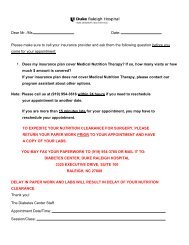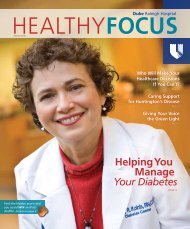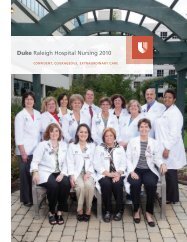Boomeritis Arthritis of the hip and knee joint - Duke Raleigh Hospital
Boomeritis Arthritis of the hip and knee joint - Duke Raleigh Hospital
Boomeritis Arthritis of the hip and knee joint - Duke Raleigh Hospital
Create successful ePaper yourself
Turn your PDF publications into a flip-book with our unique Google optimized e-Paper software.
<strong>Boomeritis</strong><strong>Arthritis</strong> <strong>of</strong> <strong>the</strong> <strong>hip</strong> <strong>and</strong> <strong>knee</strong> <strong>joint</strong>Hardy Singh, M.D.
Background…Hardy Singh, M.D.Medical School, Punjab, IndiaOrthopaedic Training, IndiaResearch, <strong>Duke</strong> University Medical CenterResidency <strong>Duke</strong> University Medical Center6 month Fellows<strong>hip</strong>, Joint replacement
Joint Efforts• Putting <strong>the</strong> springback in your steps….• Or..• Charting your courseto a more normallifestyle….
Choosing an orthopaedic surgeon…• How are orthopaedicsurgeons trained?• What is BoardCertification?• What is a fellows<strong>hip</strong>?
Topics..• <strong>Arthritis</strong>• Joint Anatomy• Treatment options
The <strong>Arthritis</strong> Foundation“Half <strong>of</strong> Americans diagnosed witharthritis don’t think anything canbe done to help <strong>the</strong>m.”
The <strong>Arthritis</strong> Foundation• <strong>Arthritis</strong> is <strong>the</strong> number one cause <strong>of</strong>disability in <strong>the</strong> U.S. *• Over 16 million adults say that arthritislimits <strong>the</strong>ir usual activities in some way. *• 8.2 million working aged U.S. adults(about 1 in 20) report work limitations dueto arthritis or <strong>joint</strong> symptoms.
Anatomy• Ligaments– Connect bone to bone• Tendons– Connect muscle to bone• Cartilage– Lubricates <strong>and</strong> cushionsmovement
• Covers bone ends inevery <strong>joint</strong>• White, slippery tissue• One-quarter inch thick• Can be damagedCartilage = Tires
What is <strong>Arthritis</strong>..?• Defined as inflammation <strong>of</strong> <strong>the</strong> <strong>joint</strong>• More than 100 different types• Affects 43 million Americans each year• Pain, swelling, <strong>and</strong> loss <strong>of</strong> motion• Most common cause <strong>of</strong> disability in US—1 in 6 affected• Two primary types– Osteoarthritis– Rheumatoid arthritis• Source—Centers for Disease Control <strong>and</strong> Prevention
Rheumatoid <strong>Arthritis</strong>• Inflammatory arthritis• Often affects many <strong>joint</strong>s at once• Can occur at any age, even children• Excess synovial fluid
Osteoarthritis (continued)• Begins as small area• Eventually results in bone-on-bone contact• Results in swollen, painful <strong>and</strong> stiff <strong>joint</strong>s
OsteoarthritisHealthy <strong>knee</strong> x-rayArthritic <strong>knee</strong> x-ray
OsteoarthritisNormal<strong>hip</strong>XrayArthriticHipX-ray
Symptoms <strong>of</strong> <strong>Arthritis</strong>• Joints warm to <strong>the</strong> touch• Joints swelling• Joint pain <strong>and</strong> immobility• Joint stiffness• Joint weakness (buckling)• Decreased activity• Impaired lifestyle• Joint deformities
Osteoarthritis vs. NormalAging• Osteoarthritis causeschanges in <strong>the</strong> bone belowcartilage• Osteoarthritis occursprimarily in weight-bearing<strong>joint</strong>s• With osteoarthritis, <strong>the</strong>water content increasesearly in <strong>the</strong> diseaseprocess
Exercise Nourishes Cartilage• Extremely beneficial.• Keeps bones strong.• Keeps <strong>joint</strong>s limber.• Streng<strong>the</strong>ns muscles.– Good muscle tone decreasesstress to <strong>the</strong> articular surface <strong>of</strong><strong>the</strong> <strong>joint</strong>.• Helps prolong life <strong>of</strong> <strong>joint</strong>s.
Types <strong>of</strong> Exercise• Walking• Swimming• Bicycling• Water aerobics• Work with physical<strong>the</strong>rapist.• Posture– Lift correctly– Rest– ADL’s
Modifying Activities <strong>of</strong> DailyLiving• Posture• Lift correctly• Rest
Weight Control(Being Overweight…)• Places extra stress on your <strong>joint</strong>s 1– 3 pounds <strong>of</strong> pressure for every 1 pound <strong>of</strong>body weight– 150 pound person can place up to 450pounds <strong>of</strong> pressure across each <strong>joint</strong>• Accelerates rate <strong>of</strong> cartilage destruction 2• Makes it harder to exercise properlybefore <strong>and</strong> after surgery 2 .• Harrington, I. J. (1976): A bioengineering analysis <strong>of</strong> force actions at <strong>the</strong> <strong>knee</strong> in normal <strong>and</strong> pathological gait.Biomed. Eng., 11:167–172.• Felson, D. T.: “Weight <strong>and</strong> osteoarthritis.” J. Reumatol, 43: 7–9, 1995.
Too much to h<strong>and</strong>le..
Ice….is nice• Decreases localcirculation• Decreases swelling• Acts as a local antiinflammatory• Decreases pain• Improves exercisetolerance
Heat… is nice• Increases local circulation• Promotes relaxation• Helps muscles <strong>and</strong> <strong>joint</strong>s stretch• Decreases <strong>joint</strong> <strong>and</strong> muscle aches
Braces <strong>and</strong> Self-HelpDevices• Back/Hip/Knee– Abdominal supports to reduce stresson <strong>the</strong> back– Long-h<strong>and</strong>led reachers <strong>and</strong> grabbersto reduce bending– Sock sliders• Knee– Bracing <strong>the</strong> <strong>knee</strong> reduces painfulinstability– Unloader braces are special <strong>knee</strong>braces to reduce stress on <strong>the</strong> <strong>knee</strong><strong>joint</strong>.
Orthotics• Properly fitting footwear is essential toalign legs• Heel wedges or orthotics help align <strong>the</strong>legs, relieving pressure on <strong>knee</strong>s• Rubber shoe inserts may reduce some <strong>of</strong><strong>the</strong> impact loading that your <strong>knee</strong>s or <strong>hip</strong>sexperience.• Canes (in opposite h<strong>and</strong>).• Walkers
Glucosamine/Chondroitinsulfate• Building block <strong>of</strong> cartilage• May be useful in streng<strong>the</strong>ningcartilage, preventing breakdown.• Can be extracted from shells <strong>of</strong>crabs <strong>and</strong> shrimp• Not a cure. Does not rebuildcartilage.• May help with keeping cartilagespongy.• Some anti-inflammatory properties.
Vitamins/ Minerals• Some studies indicate higher incidence <strong>of</strong>arthritis in people with low Vitamin C <strong>and</strong>D intake• Too much calcium does not cause arthritis– Too little calcium can cause osteoporosis• <strong>Arthritis</strong> patients should take vitaminsregularly
Medications/NSAID’s• Acetaminophen, Aspirin, Naproxen,Ibupr<strong>of</strong>en, Celebrex.• Host <strong>of</strong> NSAID’s (as needed best)• Effective in reducing swelling• Stomach <strong>and</strong> blood side-effects.• Topical Creams: Capsaicin, zostrix (fromred peppers)– Helps block pain.
Hyaluronate• Naturally occurring substance in cartilage• Relieves pain• Restores function• Provides lubrication to cartilage• Relief may last from 6 to12 months.• Hyalgan, Supartz, Synvisc, etc..• Few side effects..pseudosepsisWang CT, Lin J, Chang CJ, Lin YT, Hou SM. Therapeutic effects <strong>of</strong> hyaluronic acid on osteoarthritis <strong>of</strong><strong>the</strong> <strong>knee</strong>. A meta-analysis <strong>of</strong> r<strong>and</strong>omized controlled trials. J Bone Joint Surg Am. 2004; 86:538-545
Cortisone• Naturally Occurring Hormone.• Anti-inflammatory• Short term pain relief• Reduce swelling• Relief is variable• Long-term use may injure cartilage.Leopold SS, Redd BB, Warme WJ, Wehrle PA, Pettis PD, Shott S. Corticosteroid compared with hyaluronic acid injectionsfor <strong>the</strong> treatment <strong>of</strong> osteoarthritis <strong>of</strong> <strong>the</strong> <strong>knee</strong>. A prospective, r<strong>and</strong>omized trial. J Bone Joint Surg Am. 2003; 85:1197-1203.
Is Surgery for You?• This should be acooperative onebetween you, yourfamily, your familyphysician <strong>and</strong> yourorthopaedicsurgeon.
The OrthopaedicEvaluation• Medical historyincluding:– Previous injuries <strong>and</strong>surgeries– Current medications– Lifestyle issues <strong>and</strong>dem<strong>and</strong>s• Physical examination• X-rays• Occasionally bloodtests, MRI or bonescan
SurgeryChondroplasty, RF ablationOATS, micr<strong>of</strong>ractureCarticelOsteotomiesPartial <strong>joint</strong> replacementOrthoglide spacerTotal <strong>joint</strong> replacement
Arthroscopy• Controversial for Degenerative <strong>knee</strong>• Mechanical symptoms= success.– Relieves pain from torn meniscus, Loosebodies, pathologic plica, osteophytes, notchstenosis• Severity <strong>of</strong> arthritis= failure• Less successful with malalignment/ Gaitissues.• Arthroscopy=sham for arthritis.
Osteotomy
“Minimally Invasive”Surgery• Traditional <strong>joint</strong>replacement surgery isperformed through an 8 -10 inch incision• Some patients mayqualify for a “minimal”incision, only 4 inches to6 inches long• Your surgeon will select<strong>the</strong> best approach foryour unique situation.
Total <strong>knee</strong>/Hip replacement• Primary ComponentsFemoral componentPlastic linerTibial trayShellLinerHeadStem
Preparing for Total JointReplacement• Donate some <strong>of</strong> yourown blood• Stop taking certaindrugs before surgery• Begin exercises tospeed your recoveryafter surgery• Plan for home <strong>the</strong>rapy<strong>and</strong> rehabilitation aftersurgery
Total <strong>joint</strong> replacementRealistic expectations90 percent <strong>of</strong> individuals who undergo total<strong>joint</strong> replacement experience a dramaticreduction <strong>of</strong> pain <strong>and</strong> a significantimprovement in <strong>the</strong> ability to performcommon activities <strong>of</strong> daily living.• Survivors<strong>hip</strong>:– 90%@10 yrs– 80%@15 yrs– 75%@20 yrs.
Possible Complications• Most are successfully treatable• Types <strong>of</strong> possible complications:– Loosening– Infection– Wear– Blood clots– Dislocation– Nerve Injury
The Recovery Process• Use your "new" <strong>joint</strong>shortly after youroperation• Begin walking shortlyafter surgery• Initially, you will walkwith a walker,crutches or a cane.
Home Planning• Safety bars• Secure h<strong>and</strong>rails• Stable chair• Toilet seat riser• Remove all loosecarpets <strong>and</strong> cords• Same floor livingspace
The Recovery Process• There will betemporary pain in <strong>the</strong>replaced <strong>joint</strong>• The muscles are weakfrom inactivity• The tissues arehealing• Pain will end in a fewweeks or months
A few weeks later..
New Implant- FDA• ORTHOGLIDEapproved 2006
What type <strong>of</strong> patient is thisfor??• A patient who is havingpersistent pain mainly frominside part <strong>of</strong> <strong>the</strong> <strong>knee</strong>• A patient who’s received allo<strong>the</strong>r non-surgical <strong>the</strong>rapies<strong>and</strong> is still having pain• A patient who’s surgeon hastold <strong>the</strong>m <strong>the</strong>ir next step is aUniarthroplasty or TKR
How it works• Reduces <strong>the</strong> forces placed on <strong>the</strong> painful middlepart <strong>of</strong> <strong>the</strong> <strong>knee</strong> by redistributing <strong>the</strong>m to <strong>the</strong>o<strong>the</strong>r less painful half• Increase <strong>the</strong> contact area <strong>of</strong> <strong>the</strong> moving parts in<strong>the</strong> <strong>knee</strong>, thus reducing painful point forces• Decrease <strong>the</strong> bone-on-bone friction by providinga smooth glide path for <strong>the</strong> femur to move on
The OrthoGlideAdvantages…• Provides pain relief without compromising <strong>the</strong> <strong>knee</strong>anatomy• No bone cuts• 2-3 inches long, combined with arthroscopy• Total procedure time: 45-60 min.• Does not “Burn any Bridges”• Easy conversion to o<strong>the</strong>r surgical options (i.e. Uni, TKR)• Home next day, no Physical Therapy• Weight bearing as tolerated.
Current Patient Results100OrthoGlide Results90WOMAC Score8070605040PainFunction3020Pre-op3 Monthn=486 Monthn=481 Yearn=1
Future <strong>of</strong> arthritis• By <strong>the</strong> year 2030, an estimated onequarter <strong>of</strong> <strong>the</strong> projected total adultpopulation, or 64.9 million adults aged 18years <strong>and</strong> older, will have doctordiagnosedarthritis, compared to <strong>the</strong> 42.7million adults in 2002. *• These estimates may be conservative as<strong>the</strong>y do not account for current trends inobesity.
Closing• Education <strong>of</strong> various options• We can/must successfully treat arthritis• Surgery is a last resort• Returning patients to activity <strong>and</strong>employment is critical• We must work toge<strong>the</strong>r.
Future• Identifying high risk patients.• Genetic basis• Disease prevention through– Health– Lifestyle &– Disease modifications.
Thank youHardy Singh, M.D.





